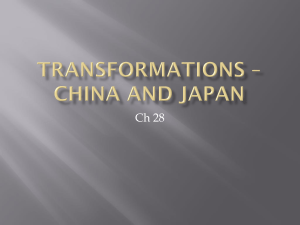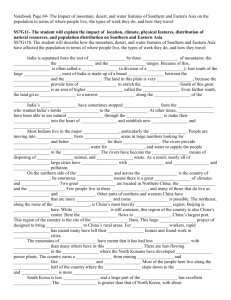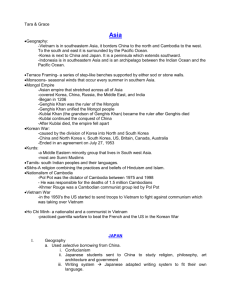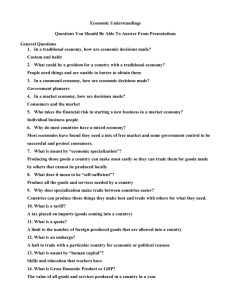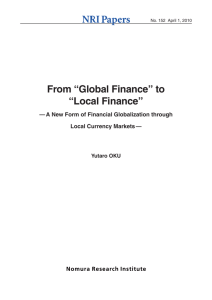File - Mrs. Ricker`s Class
advertisement
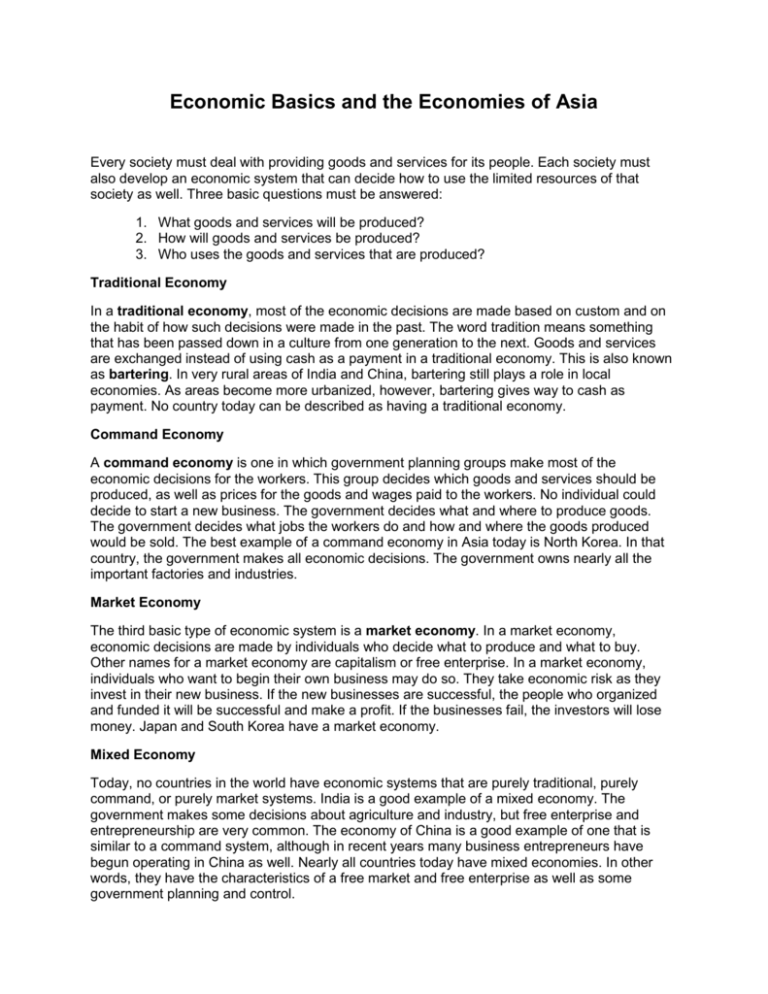
Economic Basics and the Economies of Asia Every society must deal with providing goods and services for its people. Each society must also develop an economic system that can decide how to use the limited resources of that society as well. Three basic questions must be answered: 1. What goods and services will be produced? 2. How will goods and services be produced? 3. Who uses the goods and services that are produced? Traditional Economy In a traditional economy, most of the economic decisions are made based on custom and on the habit of how such decisions were made in the past. The word tradition means something that has been passed down in a culture from one generation to the next. Goods and services are exchanged instead of using cash as a payment in a traditional economy. This is also known as bartering. In very rural areas of India and China, bartering still plays a role in local economies. As areas become more urbanized, however, bartering gives way to cash as payment. No country today can be described as having a traditional economy. Command Economy A command economy is one in which government planning groups make most of the economic decisions for the workers. This group decides which goods and services should be produced, as well as prices for the goods and wages paid to the workers. No individual could decide to start a new business. The government decides what and where to produce goods. The government decides what jobs the workers do and how and where the goods produced would be sold. The best example of a command economy in Asia today is North Korea. In that country, the government makes all economic decisions. The government owns nearly all the important factories and industries. Market Economy The third basic type of economic system is a market economy. In a market economy, economic decisions are made by individuals who decide what to produce and what to buy. Other names for a market economy are capitalism or free enterprise. In a market economy, individuals who want to begin their own business may do so. They take economic risk as they invest in their new business. If the new businesses are successful, the people who organized and funded it will be successful and make a profit. If the businesses fail, the investors will lose money. Japan and South Korea have a market economy. Mixed Economy Today, no countries in the world have economic systems that are purely traditional, purely command, or purely market systems. India is a good example of a mixed economy. The government makes some decisions about agriculture and industry, but free enterprise and entrepreneurship are very common. The economy of China is a good example of one that is similar to a command system, although in recent years many business entrepreneurs have begun operating in China as well. Nearly all countries today have mixed economies. In other words, they have the characteristics of a free market and free enterprise as well as some government planning and control. Entrepreneurs Entrepreneurs are creative, original thinkers who are willing to take risks to create new businesses and products. Entrepreneurs think of new ways to combine productive resources (natural, human, and capital) to produce goods and services that they expect to sell for a price high enough to cover production costs. They are willing to risk their own money to produce these new goods and services in the hope that they will earn a new profit. Because no one can tell how popular these new products and services will be, not all entrepreneurs can count on making a profit. Many businesses are not successful. Only about 50% of all new businesses are still operating three years after they begin. Currency Exchange With international trade, nations need a system to exchange currency. An exchange rate is set so the countries can purchase and sell items in different countries. The rupee is the basic currency for India. In 2006, roughly 45 rupees equaled US $1. The basic currency in China is the Yuan. In 2006, roughly 7.8 Yuan equaled US $1. The yen is the basic unit of currency in Japan. In 2006, approximately 118 yen equaled US $1. Specialization Not every country can produce all of the goods and services it needs. Because of this, countries specialize in producing those goods and services they can provide the best and most efficiently. They look for other who may need these goods and services so they can sell their products. The money earned by such sales then allows the purchase of goods and services the first country is unable to produce. In international trade, no country can be completely selfsufficient (produce all the goods and services it needs). Specialization creates a way to build a profitable economy and to earn money to buy items that cannot be made locally. The countries in Asia are very different in terms of how their economies are organized. India has a lot of farm land, but the population is so large it is often difficult to grow enough food for everyone. India has a booming industrial and technological economy. This specialization makes it possible for an economy as enormous as that of India to focus on those businesses that are the most profitable. China is much the same. Some areas of the country are almost all agricultural. Others have large cities and modern industries. Japan is a country with very few natural resources, so specialized industries have been developed to earn money needed to buy food and raw materials from other countries. North Korea has had many problems in their attempts to improve the harvests on their farms. As a result, the North Korean government has had to turn to industries that use the country’s natural resources like iron and coal in order to keep the economy going. Specialization allows countries to produce what they do best and generate income to buy what they still need. India India has a mixed economy where the government makes some economic decisions and businesses and individuals make other decisions. In 2005, however, the government put a stop to the privatization of the remaining government-owned industries. Traditional village farming is also a part of India’s diverse economy. The population age 15 and over who can read and write is 59.5%, but a portion of India’s population is well educated and English speaking. This is why the major source of India’s economic growth is in the services sector. India is a major exporter of software services and software workers. Services make up more than half of India’s economic output. India’s labor force is thriving because of outsourcing. Many countries in the United States outsource their work. This means that they hire people in other countries and pay them lower wages to do certain types of work. American computer companies, for instance, hire people in India to give technical support to their customers. A large portion of the workforce is in the agriculture sector. Some modern agriculture techniques are used. The government is also improving the basic infrastructure of Indian society, which will help the rural poor. Infrastructure includes systems such as communications, transportation, power lines, and structures such as schools. India does have natural resources. It has the fourth largest coal reserves in the world. India has natural gas, petroleum, diamonds, limestone, arable land, and a variety of metal deposits. Yet water pollution and non-drinkable tap water in many places are major problems in India. The ever-growing population of India remains its biggest drain on the economy, and on its natural resources. China China has a mixed economy, but for many years it had a command economy. Since Mao Zedong’s death, his successors have focused on market-oriented economic reforms. Output for China’s economy has quadrupled. The Chinese standard of living, therefore, has improved. The private sector is growing rapidly. China also has a large group of entrepreneurs who are willing to take great risks to try to achieve financial success. Chinese aged 15 and over who can read and write make up 90.9% of the total population. There is a large group of people who are unemployed because they lost their jobs in companies that used to be owned and run by the state. The state struggles to find jobs for these people, as well as for migrant workers and surplus rural workers. China struggles with air pollution, soil erosion, and decreasing water supplies. China has many natural resources, including the world’s largest potential for hydropower, coal, petroleum, and natural gas. China also has a variety of metals and minerals. The Chinese government has invested heavily into the Three Gorges Dam, across the Yangtze River. The project cost $24 billion and took thirteen years to complete. It will vastly improve electrification and flood control in the Yangtze basin. North Korea As a Communist country, North Korea has a command economy. This means that the government plans the economy and decides what is produced. It also owns all land and controls access to jobs. Unlike Japan and South Korea, North Korea is rich in mineral resources. With these resources, factories in North Korea make machinery and military supplies. However, most factories use out-of-date technology. As a result, North Korea is poorer than most other countries in East Asia. North Korea, one of the world's most centrally directed and least open economies, faces chronic economic problems. Industrial capital stock is nearly beyond repair as a result of years of underinvestment and shortages of spare parts. Large-scale military spending draws off resources needed for investment and civilian consumption. Severe flooding in the summer of 2007 aggravated chronic food shortages caused by on-going systemic problems including a lack of arable land, collective farming practices, and persistent shortages of tractors and fuel. Since 2002, the government has allowed private "farmers' markets" to begin selling a wider range of goods. It also permitted some private farming - on an experimental basis - in an effort to boost agricultural output. In October 2005, the government tried to reverse some of these policies by forbidding private sales of grains and reinstituting a centralized food rationing system. Firm political control remains the Communist government's overriding concern, which will likely inhibit the loosening of economic regulations. Japan Today Japan is an economic powerhouse. However, this was not always the case. Until the 1950s, Japan’s economy was not that strong. Within a few decades, though, the economy grew tremendously. The most successful area of Japan’s economy is manufacturing. Japanese companies are known for making high-quality products, especially cars and electronics. Japanese companies are among the world’s leading manufacturers of televisions, DVD players, CD players, and other electronic items. The methods that companies use to make these products are also celebrated. Many Japanese companies are leaders in new technology and ideas. Many factors have contributed to Japan’s economic success. One factor is the government. It works closely with business leaders to control production and plan for the future. Japan’s workforce also contributed to its success. Japan has well-educated, highly trained workers. As a result, its companies tend to be both efficient and productive. Most works in Japan also have a strong work ethic. A work ethic is the belief that work in itself is worthwhile. Because of their work ethic, most Japanese work hard and are loyal to their companies. As a result, the companies are successful. Japan’s economy depends on trade. In fact, many products manufactured in the country are intended to be sold outside of Japan. Many of these goods are sent to China and the United States. The United States is Japan’s major trading partner. Japan’s trade has been so successful that it has built up a huge trade surplus. A trade surplus exists when a country exports more goods than it imports. Because of this surplus, many Japanese companies are very wealthy. Japan is able to export more than it imports in part because of high tariffs. A tariff is a fee that a country charges on imports and exports. For many years, Japan’s government has placed high tariffs on goods brought into the country. This makes imported goods more expensive, and so people buy Japanese goods rather than imported ones. Although its economy is based on manufacturing, Japan has few natural resources. As a result, the country must import raw materials. In addition, Japan has little arable land. Farms cannot grow enough food for the country’s growing population. Instead, the Japanese have to buy food from other countries, including China and the United States.






